

20. Salt Satyagraha |
A new determination to force the Government to act filled the minds of the people. 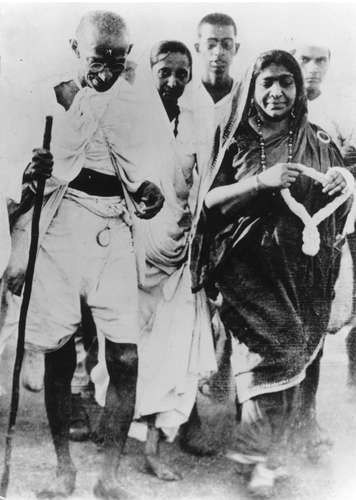 With Sarojini Naidu on the march to Dandi Jawharlal Nehru was elected President of the Congress at the instance of Gandhi. A Congress session was held in Lahore on December 31, 1929. A resolution announcing that full independence was India's goal was passed at this session of the Congress. Disappointed at her failure to get dominion status, India now demanded full independence. The whole country was excited. Everybody was waiting for the lead from Gandhi. After two months of suspense, a Salt Satyagraha was announced by Gandhi. This would be the beginning of a civil disobedience campaign in which laws made by the State would be broken. Civil disobedience would begin by breaking the salt law. 'Salt suddenly became a mysterious word, a word of power,' Nehru said. The Government had put an excise tax on salt which brought an enormous amount of money to the treasury. Moreover, the Government had the monopoly of manufacturing salt. The salt tax was to be attacked and salt laws were to be broken. The very simplicity of Gandhi's choice made the issue more dramatic. On March 2, 1930, Gandhi wrote a long letter to the new Viceroy, Lord Irwin, about the deplorable condition of India under British rule. British rule', he said, 'has impoverished the dumb millions by a system of progressive exploitation, and by ruinously expensive military and civil administration which the country can never afford. It was reduced us politically to serfdom. It has sapped the foundation of our culture. He requested the Viceroy to see him and discuss the matter with him in person. 'But If you cannot see your way to deal with these evils,' he went on, 'and my letter makes no appeal to your heart, on the eleventh day of this month I shall proceed with such co-workers of the Ashram as I can take, to disregard the provisions of the salt laws. It is I know, open to you to frustrate my design by arresting me. I hope there will be tens of thousands ready in a disciplined manner, to take up the work after me. 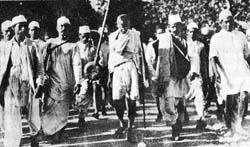 The march to Dandi, 1930 Lord Irwin did not answer Gandhi but sent a message through his secretary expressing regret that Gandhi had chosen a course which involved breaking the law of the land and which would be a danger to public peace. The whole of India was agitated over Gandhi's Salt Satyagraha. On March 12, at 6.30 in the morning, thousands of people watched as Gandhi started from his ashram with seventy eight volunteers on a march to Dandi, a village on the sea coast 241 miles away. There, it was announced, the salt law would be broken. Gandhi led the march through village after village, stopping at each place to talk to the peasants and advise them on the necessity of social reforms. For twenty-four days the eyes of India and the world followed Gandhi as he marched towards the sea. The Government did not take the risk of arresting Gandhi. With each passing day the campaign grew. Hundreds and thousands of people joined the procession. Men, women, and children lined the route, offering flowers and shouting slogans for the victory of the march. Newspaper reporters from every corner of the world were there to report the progress of Gandhi's march. 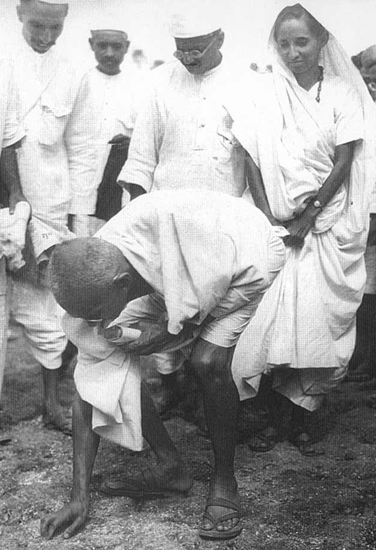 Picking up salt to break the law The march ended on April 5 at Dandi village. Gandhi and his selected followers went to the sea-shoe and broke the salt law by picking up salt left on the shore by the sea. Gandhi then gave a signal to all Indians to manufacture salt illegally. He wanted the people to break the salt law openly and to prepare themselves for non-violent resistance to police action. All over India people swarmed to the nearest sea coast to break the salt law. Great excitement was created everywhere. Only a few people knew how to make salt, but the people soon found their own ways of making it. All that mattered was the breaking of the salt law. Gandhi and other leaders had made arrangements for the continuation of the agitation if they were arrested. A chain of leaders had been chosen, so that as each leader was arrested another would be ready to take his place. The Government waited for some time before taking any action, and then at last retaliation began. Gandhi was left at liberty, but many other leaders were taken into custody. Jawaharlal, Mahadev Desai, and Gandhi's son Devdas were the first to be sent to the jail. In dealing with the breakers of the salt law, the police resorted to their usual brutal methods. The Indian National Congress was declared illegal. Some newspapers which were threatened with censorship suspended publication. The people held hartals and demonstrations, and mass arrests were made. Soon the jails were filled to overflowing. The people remained non-violent, lest Gandhi should call off the movement. Gandhi then informed the Viceroy that the was going to raid the government salt works at Dharasana. Lord Irwin decided to act. Two English officers, with pistols, accompanied by many Indian policemen armed with rifles, arrived at Gandhi's camp in the middle of the night. They woke up Gandhi and said, 'You are under arrest.' Gandhi was taken to Yeravda Central Jail.  In many parts of India people broke the salt law So Gandhi was not there for the raid on the Dharasana salt deposits. The salt deposits were surrounded by the barbed wire fencing and protected by four hundred Indian policemen armed with steel shod lathis. A few British officers were in command of them. Gandhi's volunteers halt some distance away from the fencing. Then a selected group of them advanced towards the barbed-wire fence. Police officials ordered the volunteers to disperse but the police ignored the warning. 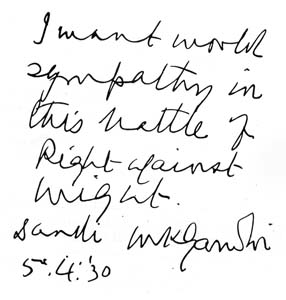 Suddenly the police rushed at them and rained blow after blow on the defenseless men. Not one of the volunteers even raised an arm to stop the blows. They fell down, some with broken skulls, some with broken shoulders, arms, or legs. The waiting crowd groaned. When the entire first batch had been knocked down and carried off on stretchers, another batch advanced to meet the same fate. The campaign went on for hours. Finally, as the heat of the day increased, the volunteers stopped their activities for that day. Among the volunteers two had died and 320 were injured. Gandhi's arrest had created a great sensation in India and abroad. Representations were sent from all parts of the world to the British Prime Minister asking the Government to release Gandhi and make peace with India. Even those who were co-operating with the British demanded the release of Gandhi. Gandhi proved to be more dangerous inside the jail than outside. While he sat quietly in Yeravda Jail, country wide outbreaks of civil disobedience were greatly taxing the British. The jails were full to overflowing. The Government was in distress and finally, in 1931, had to release Gandhi, Nehru, and other leaders. As soon as Gandhi was out of prison he asked for an interview with the Viceroy, Lord Irwin. The interview was immediately given. Gandhi and Irwin met, but the two men seemed to have come from two different worlds.  At Bombay before departure, with Pandit Madan Mohan Malaviya, Sarojini Naidu, and Kasturbai Gandhi did not go to seek any favours. He wanted to negotiate on terms of equality. The meeting went ton for many days and finally the talks culminated in a treaty, the Gandhi Irwin Pact. It embodied compromises made by both sides. Irwin agrees to release all the political prisoners, and Gandhi promised to suspend civil disobedience and send a Congress representative to the round Table Conference. For at that time, in London, the British Government was holding a Round Table Conference on the future of India. The Gandhi Irwin Pact was a victory for non-violent resistance. But some of Gandhi's Congress followers thought that he had not gained much as result of the pact. Gandhi was designated as the sole reprehensive of the Congress to the Round Table Conference. In August 1931 he sailed for London with a small party. Gandhi went to England with the object of reaching an agreement with the British on affair Constitution for India and also of winning the hearts of the British people. In his first object he failed, and in the second he met with great success. Gandhi spent eighty four days in England and most of the time he was meeting and talking to people. Churchill refused to see him but Gandhi captivated the hearts of many. He had tea with the King and Queen. When a reporter asked him if he though t he had dressed well enough for such an august tea party, Gandhi replied, 'The King had on enough for both of us.' At the Round Table Conference nothing was conceded to India towards her goal of swaraj. The Conference played up the differences between Hindus and Muslims, and this only served to worsen communal tension in India. Gandhi returned with nothing except warm goodwill for India from the hearts of many English people. 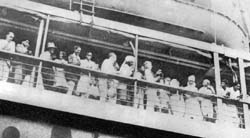 On board the S. S. Rajputana 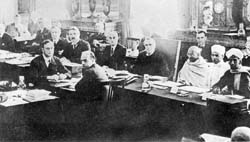 At the Round Table Conference 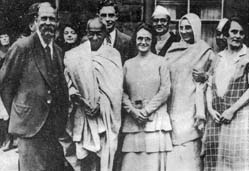
At Marseilles, with C. F. Andrews, Miss Muriel Lester, Mahadev Desai, Miraben, and Pyarelal 
With women workers in a Lancashire cotton mill |